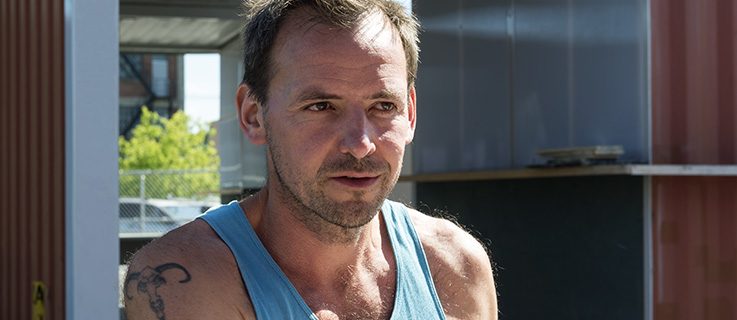Inspired by the Montreal landmark Mont Royal, Mont Réel, a collaboratively-built hill was erected in the summer of 2017 and is already serving as a creative meeting place for residents and artists.
For three weeks, architects, designers, cultural professionals, artists and students from Germany, France and Canada built, researched, designed and cooked on the grounds of a former railway yard. With Mont Réel, the participants not only developed an inviting installation, but also a whole new community. The project was initiated by the Goethe-Institut Montreal in partnership with the Consulat général de France à Québec and the Université de Montréal; the artistic direction was the responsibility of the European collective Constructlab. We spoke with its Berlin-based founder Alexander Römer.
Alexander Römer, what is a typical Constructlab project like?
The projects by Constructlab arise from the common desire of the parties involved not only to conceive projects but also to build them themselves. I often describe the network as a “community of interests.” For certain projects, we come together in different constellations, whereby interested parties outside the network can also get involved. This collaboration creates a temporary collective. The approach is always similar, but the results differ greatly since they are also determined by local conditions. Typical elements are togetherness, teamwork as well as a certain degree of uncertainty due to the interaction with our environment. We want and maintain an exchange of existing resources, because we want to create a place where debates take place. For this reason, our structures are often built in the form of an agora, the central meeting place in the cities of ancient Greece.
A place where debates are held
When the Goethe-Institut invited you to develop a project for Montreal, you were given carte blanche. Why did you choose the grounds where the new MIL campus is being built?
In Montreal, we specifically looked for a place where a local initiative already exists. We spent a week visiting a wide variety of places together with the Goethe-Institut during a research trip last year. We wanted to find a place where we could play an intermediary role and where this role is needed. Similar, for example, to our project The Arch in Genk (Belgium), where we were invited to activate a place for three months. After this structure was built, we literally moved in and brought life directly to the place. Here in Montreal, we opted for the MIL campus, a new science campus of the Université de Montréal located on a former freight terminal at the intersection of three very different Montreal neighbourhoods: middle class Outremont, the vibrant artists’ quarter of Mile End and Parc Ex, a neighbourhood with a high proportion of first-generation immigrants from many different countries.
A new campus like this certainly brings about changes for the neighbourhood and no one can predict exactly what they will be. There are people who are afraid of these changes or have even already developed a strategy to combat them. We want to invite these people to talk to us. We want to create a place where the debate can be held about the evolution of this neighbourhood. A project like Mont Réel provides this possibility, a common space; a built urban laboratory in which social research is actively pursued.
Why did you decide to build it in the shape of a hill?
The hill as a theme goes back to the idea of making a copy of Mont Royal. The use of this symbol is an attempt to transfer the strong social dynamism associated with this park to Mont Réel. Everyone here knows Mont Royal, has already experienced something there and has a connection to this important landmark.
-
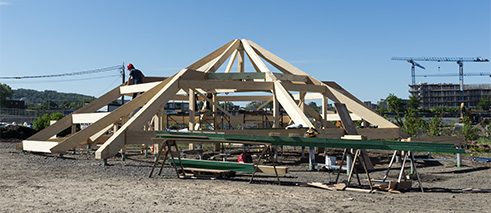 © H. Kaluppke
© H. Kaluppke
Mont Réel - the basic structure
-
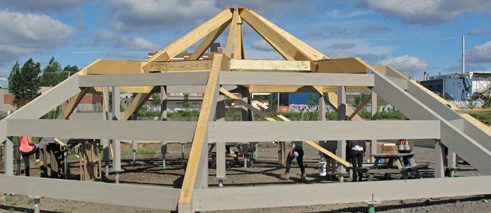 © Goethe-Institut Montreal
© Goethe-Institut Montreal
Mont Réel - the basic structure
-
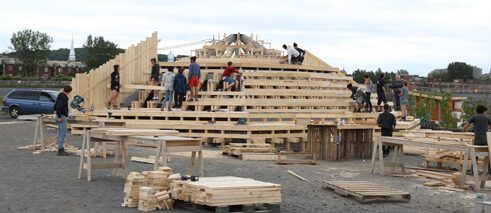 © Marie-Emanuelle Boileau
© Marie-Emanuelle Boileau
Construction work at Mont Réel
-
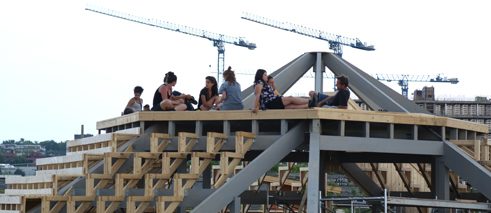 © Marie-Emanuelle Boileau
© Marie-Emanuelle Boileau
Construction work at Mont Réel
-
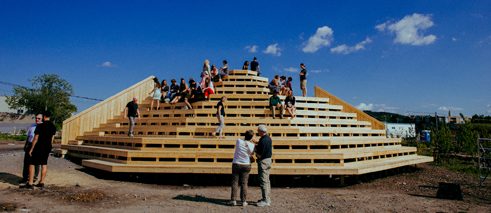 © Gupta
© Gupta
The Mont Réel at the inauguration
-
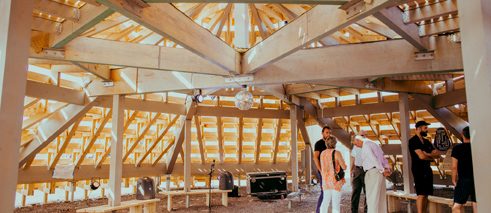 © Gupta Ashutoshk
© Gupta Ashutoshk
The interior
An agora, a gathering place, can take on all sorts of thematic forms. Spatially, it should be a concentric shape and geometrically simplified, an octagon is also well suited for implementing the hill theme. The outer form is a reverse agora. The slopes of the hill become steps to sit on and small lateral outcrops are stages. The deep ravines will lead to entrances inside. Inside, the focus is on the centre, while on the outside, the visitors sit on the sides of the hill and look away from it.
A Public Laboratory
You worked for three weeks on the structure with 10 mentors/artists and 20 participants, while the actual construction was not all you did. What was the process?
Building was, in fact, only the first step. First, we needed what we call a support structure; a physical structure that enables us to become active. Therefore, together with the people involved in this workshop, we built this first shape as a wooden structure. It is very important to note that the different skills of the participants are equated and brought together for the project. Everyone is important, whether as a planner or cook, everyone has to enjoy the work and be proud of their contribution. That is the only way for the overall project to be successful.
Parallel to the creation of this constructed, visible form, it will be used by us as a stage on which engagement will arise in various activities and encounters. This is what we call the living form: the prototypical, experimental design of activities and improvisations in this new public space.
We have planned a variety of activities at Mont Réel: excursions in the neighbourhood, for example, to build a bridge between the various districts with their very different social components through the vocal workshops by Dina Cindric and Greg Gilg. In addition, there were many other activities, such as Costanza Matteucci and Malte Martin’s printing and graphics workshop, Pascal Lazarus’s fermentation studio as well as spontaneous artist talks and meetings, sound installations and workshops with Florence Blain, Jen Reimer and Max Stein, our Saturday brunch, the performance with Mélanie Binette and picnics.
-
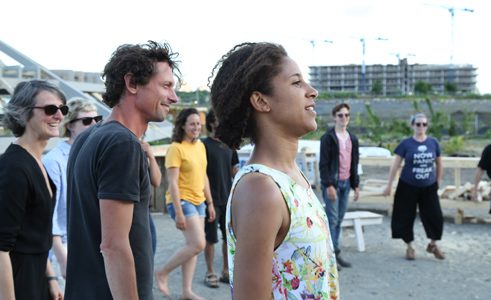 © Marie-Emanuelle Boileau
© Marie-Emanuelle Boileau
Singing workshop with Florence Blain Mbaye
-
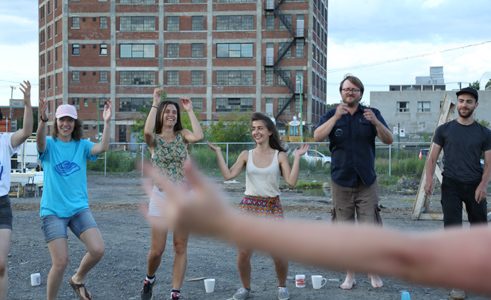 © Marie-Emanuelle Boileau
© Marie-Emanuelle Boileau
Singing workshop
-
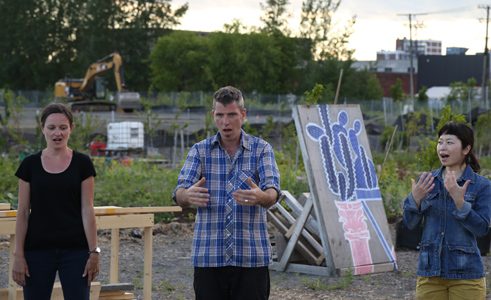 © Marie-Emanuelle Boileau
© Marie-Emanuelle Boileau
Singing workshop with Grégoire Gilg
-
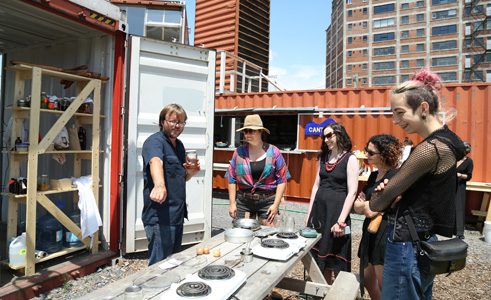 © Marie-Emanuelle Boileau
© Marie-Emanuelle Boileau
Fermentation workshop with Pascal Lazarus
-
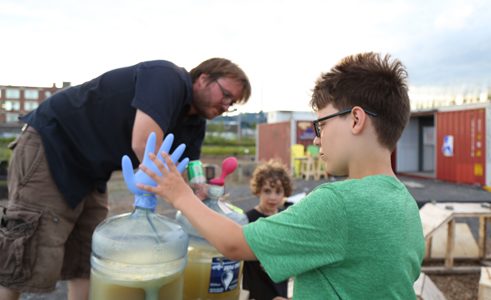 © Marie-Emanuelle Boileau
© Marie-Emanuelle Boileau
Workshop fermentation
-
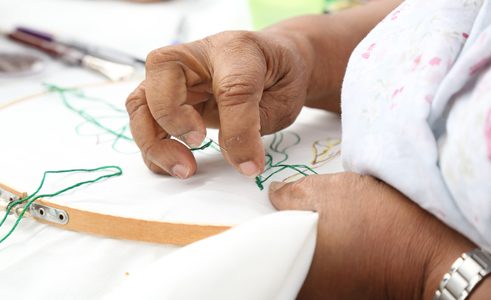 © Marie-Emanuelle Boileau
© Marie-Emanuelle Boileau
Coloring-Workshop
-
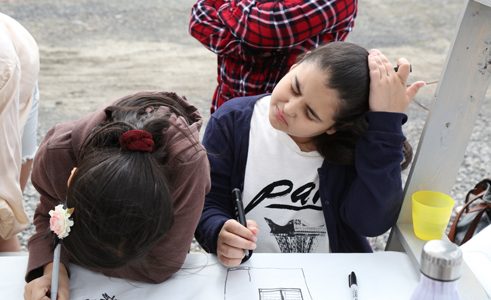 © Marie-Emanuelle Boileau
© Marie-Emanuelle Boileau
Coloring-Workshop
-
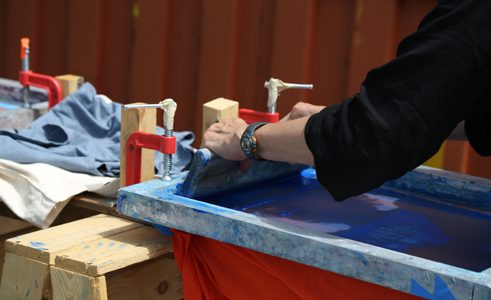 © Marie-Emanuelle Boileau
© Marie-Emanuelle Boileau
Graphic and print workshop
-
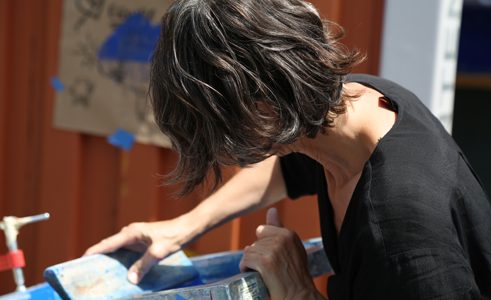 © Marie-Emanuelle Boileau
© Marie-Emanuelle Boileau
Graphic and print workshop
The third form is its use after the project phase, the question as to how we can bring aspects of popular science into the project. We call this science campus the popular science form. The Université de Montréal plans to expand the campus of its engineering faculty over the next five years. We thought that the hill would be an exciting opportunity in the meantime to bring the research, which is usually conducted behind thick walls and only in the laboratory, into the public and to make it tangible for local audiences. A public laboratory, which would stay there for one year at first. We do not yet know who will be involved – this scientific residency depends on our partners at the university and local decision-makers.
New Artistic Forms
How did the residents react during the three-week workshop – what feedback did you get?
There are almost no immediate residents at the grounds; the former marshalling yard is located between active track systems, which are real obstacles. The connecting road has been redesigned and now that construction work has been completed, there will be new accesses to the site. First, the place has to be noticed again in the neighbourhood. The idea of building a hill together in the newly emerging part of the city attracted attention and with the vocal and other workshops during the project phase, we were already able to get some local residents interested in the place.
Mont Réel will remain on the MIL campus for a certain period of time. How do you foresee the future of the hill? What activities have been planned, what scenarios are possible?
Mont Réel is available both as a space for the already active local initiatives as well as for events by the theatre, music or art scenes of Montreal. Basically open to any user, its form and symbolism will surely inspire people. Mont Réel is suitable, for example, for plays or other performances, but it also offers opportunities for everyday activities, like picnics with a good view, or inside in a sheltered and quiet space for meetings, rehearsals and concerts. New artistic forms are possible, spectators could sit outside on the mountain while an orchestra is playing inside underneath them, or the garden might become a stage surrounding the hill. Mont Réel is a space of opportunity for art and design. I would hope that in the next few years creative use will become established and that either the place itself will be available for longer than planned or the hill will be moved to a different location once its time of use ends.
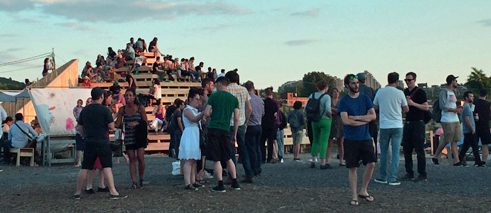 Mont Réel at the inauguration
| © H. Kaluppke
Mont Réel at the inauguration
| © H. Kaluppke
Mont Réel is part of “Germany @ Canada 2017 - Partners from Immigration to Innovation”, a special cultural program presented by the Goethe-Institut and the German Embassy highlighting the German-Canadian friendship in honour of Canada's sesquicentennial year.
